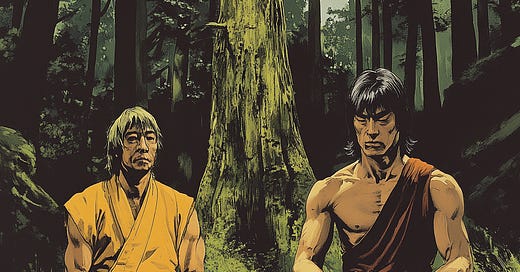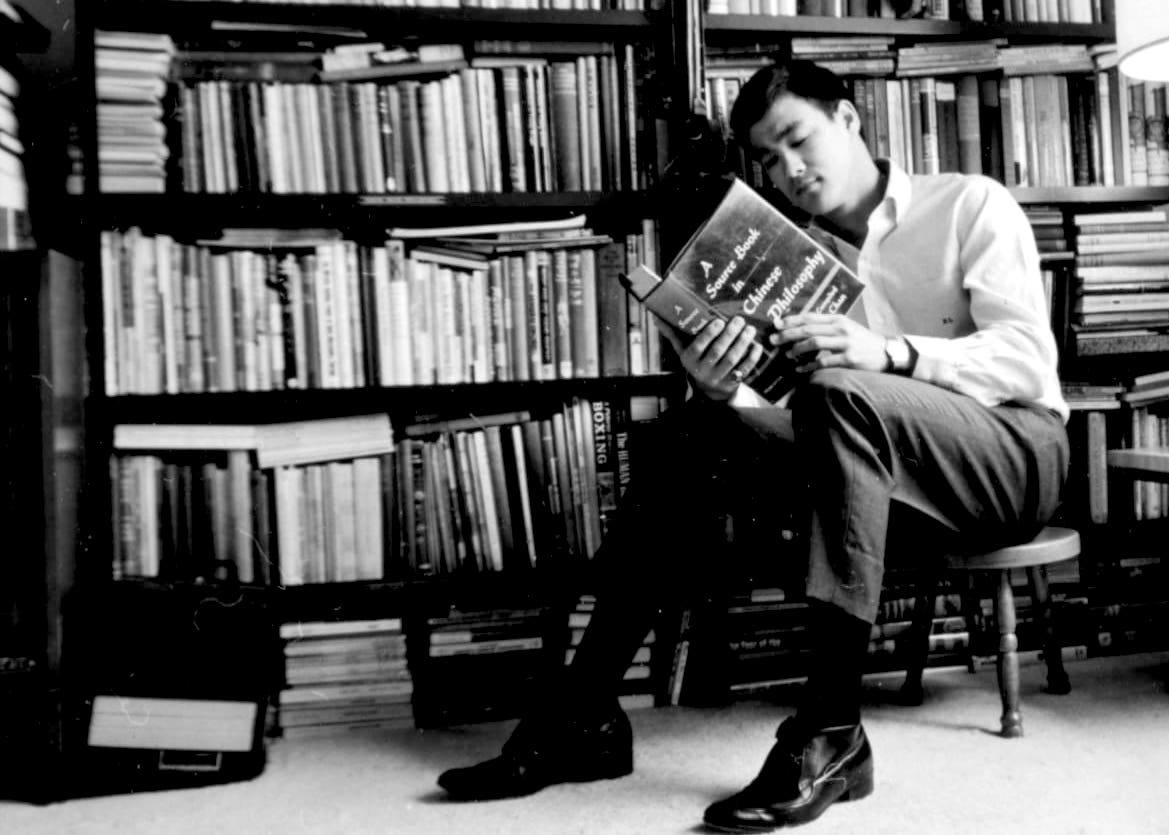What Do The Master And The Novice Have In Common?
Lessons from a metal guitarist and a martial arts icon on how you can tap into The Infinite Journey
Consider the following question:
What do the master and the novice have in common?
As is the case with all great questions, there is no “right” answer, but only the right answer for you.
In this article, I talk about my lifelong journey with this question and the inspirations that shape my personal answer. I invite you to read what follows not to persuade you of my conclusion, but to give you some inspiration for finding your own.
At the end of the day, looking for the most important answers outside is a fool’s errand. Your reality is created by your Listening, and your Listening comes from within.
I invite you to see from where I Listen, and that it may be a vantage point from which you may find your own perspective.
For both of the case studies, we will give surrounding context and then provide actionable takeaways. If you’re pressed for time, simply Ctrl+F and search “That’s A Nice Story, Charles, What Do You Want Me To Do With This Information?”
Let’s dive in.
Randy Rhoads
One of my favorite guitar players growing up was Ozzy Osborne's Randy Rhoads. To this day, my parents probably still have the intro to "Crazy Train" stuck in their heads from when 12 year old Charles locked himself in his room until he got every note of it just right - with many an earnest mistake along the way.
Lest this post be misinterpreted as a public apology, I'm keenly aware that this karmic debt is one I'm likely to pay back 10x when my future son goes full "Whiplash" on me and decides that drumming is his life's calling...
In any case, my room at the time was a shrine to the single-minded pursuit of 6 string excellence. Anyone not frightened away at the rattling door, hanging on for dear life against the sonic assault of a Marshall tube amp, would enter Maze Runner: Guitar Edition - a landscape fraught with trip wires (instrument cables) and perilously leaning walls constructed out of stacks of Guitar World magazine and Hot Licks VHS tapes.
Amidst the hundreds of guitar magazines, one stands out in particular: Guitar World March 2006. Although I couldn't tell you much about the rest of it, there was one anecdote that has stuck with me for nearly 20 years, although it's only now that I can really appreciate it.
There were many stories of Randy Rhoads' musical brilliance, with several notable guitarists and musicians sharing their testimonials of his prodigious acumen. Between the glowing endorsements was one story in particular that to this day guides how I approach life:
Whenever he was on tour, the first thing Randy would do when he got to a new town - while his bandmates chased groupies and partied - was open up the yellow pages to look for a music teacher. It didn't matter where in the world he was, or that he was one of the most celebrated rock guitarists of all time, or that in most cases when he would show up he would be met by a starstruck teenager, teaching guitar to local youths as a way to make a little summer money (the "lesson" in these cases would be Randy doing the teaching, then paying for the privilege of doing so).
The anecdote is moving: One of the greatest guitar players of all time took delight in the possibility that people had things to teach him, and maintained that orientation despite contrary evidence. His ego could have easily gotten the better of him: Randy could have said "I don't need to learn from anybody.”, He could have concluded after so many disappointing encounters with teachers that weren’t able to pass on the knowledge he so desperately sought that there really was nothing more he could learn. He could have let that justify sinking into nihilism and falling into the same superficial indulgences of his bandmates. He could have charged enormous fees to conduct seminars and opine on what he already knew to adoring fans.
But neither of those things afforded the possibility of becoming better. and if there was even a 1% chance of that happening, Randy was going to do whatever it took to seek that out - even if that meant 99% of the time he would actually be paying for the privilege of teaching the person who was meant to be teaching him.
In this respect, the master and the novice did not differ at all - Randy Rhoads sought betterment at his craft with the same hunger and vigor of a novice developing his first set of callouses, and by all reports maintained that perspective until the left this eart
That’s A Nice Story, Charles, What Do You Want Me To Do With This Information?
The actionable takeaway? In the words of Alex Hormozi: “Don’t invest in the S&P 500, invest in the S&ME500”. Stephen Courson blew my mind with this reframe when we met at a seminar: Financial advisors will recommend you save a fixed percentage of your income, but very rarely will you hear the same advice when it comes to investing in your own self-development Taking 10, 15 or even 20% of your monthly salary and committing it toward investing in mentorship will yield many multiples of return beyond any financial asset you can put your money in to.
Objections to this allocation typically come from a misguided sense of risk aversion as well as a false dichotomy. Let’s address that:
“What if I don’t learn anything and get nothing out of my investment?”
Investing in asset markets, absent entry and exit points, is a fundamentally passive endeavor. In other words, once your money is in, you have ZERO control over the decisions or vicissitudes of fortune that ultimately determine the return of your investment. Learning, on the other hand, is an active experience - the more you put in, the more you get out - when you invest in mentorship, what you get out of it is constrained only by what you do with the information you get and the connections you draw with
“What if the person I pay to learn from isn’t ‘the best person to learn from’?”
There’s a reason I used Randy Rhoads as an example for this section - the idea that you cannot learn from somebody is a fundamental limiting belief. If you invest in learning and get something other than what you expected, good: You’ve now exposed an area of the map that was previously gray, and have a concrete model of what NOT to do. Via Negativa is a powerful framework to equip yourself with - TLDR: Learning what to AVOID is a powerful step in learning what to EMBRACE. As such, WHO you learn from is fundamentally secondary to your willingness to learn and your attitude around doing so.
With these limiting beliefs overcome, I invite you to go out into the world, humble yourself and invest your income into acquiring the skills, knowledge and perspective to build a new reality. The only failure comes from not trying, and as Seneca chides “You act like mortals in all that you fear, and..immortals in all that you desire.”: What do you really have to lose? Time waits for no man, and every day that goes by where you don’t acquire new skills is one less day you have to deploy them. Get to it!
Bruce Lee
I was very blessed to have grown up abroad in Thailand in an era before “modern” television.
Most of the Western movies available to me were 20 or 30 year old martial arts flicks - chosen presumably as a byproduct of cheaper licensing fees and a lower language barrier (gun fights and explosions are the same in all languages, after all). In any case, while I shredded away on the guitar, endless re-runs of Arnold Schwarzenegger, Sylvester Stallone, Jean Claude Van Damme, Chuck Norris, Jason Statham and Steven Seagal would play on a loop in the background - influences who would change my life forever.
Among my action hero retinue was Bruce Lee, who said it so succinctly in the way that has since become a trope of wise martial artists: “Absorb what is useful, discard what is not, add what is uniquely your own”
His personal martial arts philosophy is built on these axioms - famously combining Wing Chun, boxing, fencing, Muay Thai, Judo, Karate, grappling and Taekwondo into something greater the sum of its parts.
Bruce Lee’s thirst for knowledge extended beyond the constraints of martial arts, with over 2,200 books encompassing philosophy, psychology, self-help, bodybuilding and sales archived to date by The Bruce Lee Library Research Project. Some particularly noteworthy highlights (via TBLRP):
22 books on or about Krishnamurti; he bought his first Krishnamurti book Think on These Things on November 19, 1966 at Pickwick Bookshop in Hollywood, along with Charles Lohse's Creative Selling and the 1916 book The Fighting Man
68 books on the art of fencing
300 boxing books
140 books on physical fitness, kinesiology, weight training, bodybuilding, and physiology
200 books on acting and filmmaking
63 books about wrestling
6 books on Gestalt Therapy
Several papers on Newtonian Physics
That’s A Nice Story, Charles, What Do You Want Me To Do With This Information?
A zest for knowledge is a zest for life, and the creative exercises a muscle which can be flexed across domains. However, unlike physical musculature, it’s the perspective of the author that creativity has no linear constraints, instead growing in an exponential fashion - the more you create and the more you learn and synthesize to feed that flywheel of creation, the wider a base you can draw from, allowing for the repetition of the cycle with increasing ferocity.
As you write, you will discover what for you is useful, develop the confidence to discard what is not, and uncover the voice to add what is uniquely yours.
One of my favorite tools for harnessing and nurturing this type of exponential growth is Obsidian. The linking feature allows users to connect notes that on the surface may seem unrelated, and the more you write the larger a repository of cross-linked notes build up - creating the kindling for unique synthesis and novel insights that wouldn’t otherwise form even with the same volume of notes.
For those with a preference for the analog, Ryan Holiday’s Common Place Box Method (a framework he learned from his mentor Robert Greene) accomplishes the same thing - allowing ideas that would otherwise not cross pollinate to interact and providing the requisite materials for you to generate new ideas as a result.
Your homework for this section? Start writing and developing a system that breaks down the silos between your ideas and allows for your writing to interact with itself. Like investing financial capital into your own self-improvement, the sooner you start investing your TIME into writing the sooner you will start to build the muscle of examining your own beliefs. A common objection we hear to this practice is “I’m not a good writer”. Leaving aside the absurdity of refraining from development of a skill you’re not yet good at, here’s a framework to take some of the pressure off:
Take notes on something you’re reading
Expand those notes into an outline
Expand that outline into a journal reflecting on the ideas in the outline
Start pulling in notes/outlines from other materials you’ve given the same treatment
Congratulations, you now have an article derived by your own unique synthesis.
To speed up the inevitable question of “which method should I go with?” I encourage you to consider which repository you’ll interact with the most. Don’t overthink this: At the end of the day, so long as you’re flexing your creativity you will experience the benefits and your tools need to serve you vs. the other way around.
Conclusion
It’s only fitting that we conclude this article by coming full circle. In the same way that the Master and the Novice are separated only by relativity, our article ends with answering a question with an answer that will only beg another:
What do the Master and Novice have in common?
In my mind, it’s something like this:
Both know what they know.
Both know what they don’t know.
Neither don’t know what they don’t know.
And both sacrifice who they were in order to become who they’re meant to be.
The prescription for the Master and Novice alike, whether lifelong 10th degree black belt or day 1 green horn - are the same: Epistemic humility, open-mindedness, a life long commitment to seek out the wisdom of others, a childlike joy in exercising creativity, and a fearless willingness to confront the limits of their comfort zone.
If you made it to the end, I thank you for your time and leave you with an invitation to stand on the shoulders of giants by taking these principles, stowing the anchor of ego and setting sail on your own uniquely personal journey into the beautiful unknown.
I’d say I see you when you get home, but for better or worse this is not a journey from which one ever returns - each step you take leaves who you were further and further in the rear view mirror, and the new eyes from which you see the world creates a new reality. Just as Frodo returned to the Shire from Mount Doom a new Hobbit, and that new Hobbit created a new Shire, so too will you and your environment interact in an endlessly beautiful feedback loop of growth and change.
For our parting words, I give you the timeless wisdom of Immortal Technique:
“From now on, it can never be the same as before, because the place that I'm from doesn't exist anymore”








I enjoyed this so much! Took notes 😊
Amazing read.
Again.